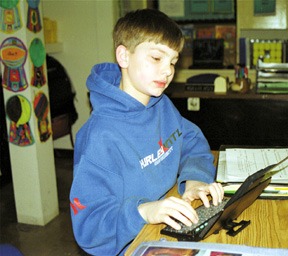When technology knocks, kids answer.
Who’d have thought a generation ago that fifth-graders would be using little hand-sized gadgets that look like a Star Trek communicator to complete school work?
Speaking of Star Trek, the kids can even “beam” each other information.
Ryan Evans, 11, worked on his Palm Pilot, attached to a scaled-down keyboard, writing a persuasive essay.
“I like typing on the Palm more than writing, because I’m pretty good at typing,” Evans said.
Alena Staple, 10, and Jordon Harris, 11, demonstrated another bit of cool technology. Staple and Harris had a laptop computer hooked up to a Smartboard, which is a high-tech version of the old chalkboard. The two demonstrated their ability to run a Powerpoint presentation, displayed both on the screen of the laptop and on the Smartboard.
“It’s a lot funner because you can use pictures and sounds. It’s really quite amazing,” Staple said. “The whole class can see it so we don’t have to huddle around one computer.”
Such technological prowess among students is the result of the efforts of one Oak Harbor School District teacher who has managed to get the latest in technological gadgets for her fifth-grade students at Clover Valley Elementary School.
Using Palm Pilots, computer software and other accessories, the students in Roxane Moir’s class have met her high expectations academically, and have gained computer technology skills in the process.
Moir’s class isn’t made up of all the gifted students. Rather, it is an average sampling of 10 and 11-year-olds, not unlike any fifth grade class at any public elementary school, anywhere in the country.
“I really feel strongly that technology has a place in education. These kids have to be competitive with big city kids,” Moir said on Monday.
That simple belief was the motivation behind Moir’s quest to provide such technology to her students, despite the lack of money in the district budget.
“I write and write and write grants. I teach these kids that by writing there’s power in it. Now, they all want to write to the government, too,” Moir said.
Moir is an “Intel master teacher.” She was trained in computer technology using a grant from Intel Corporation. As a master teacher, she trains 20 other teachers in the district, per year, on how to use technology in the classroom.
But, all the cool stuff that Moir’s students have at their disposal is the result of a $40,000 grant Moir received from the Technology Literacy Challenge Fund. The TLCF Digital Tools Grant provided the Palm Pilots and accessories, as well as a list of other technological tools, for Moir’s classroom.
Moir said the children in her class have “very solid grades.” And, she credits the technology for their success.
“It’s my personal experience that technology has the greatest impact on special ed kids, ADHD kids and gifted kids,” Moir said. ADHD stands for Attention Deficit Hyperactivity Disorder.
Students who once disliked writing now enjoy it and are good at it, Moir said, because the Palm Pilots have made it enjoyable and accessible for them to produce written works.
“He tends to write a lot more and higher quality on the Palm,” Moir said of student Michael Scott.
Scott, 11, concurred.
“It’s quite fun and easy,” Scott said, as he demonstrated his skill with a Palm Pilot. “We do memo pad, games and other math projects on it.”
Classmate Ashley Hawkins, 10, agreed that the Palm Pilot has helped in her classwork.
“A lot, because we don’t have to write down as much,” Hawkins said.
Additionally, students are able to write paragraphs, for instance, and send them other Palm Pilots through a wireless transmission, called “beaming.”
“It’s a great communication tool for team work,” Moir said.
Parental response to technology in the classroom has been extremely favorable, Moir said, although she added, “They’re a little wowed.”
It’s understandable.These children are using tools that were unimaginable a generation ago.
The students also know how to impress an audience. Ben Ducken, 10 and Anthony Patterson, 11, designed a page on the computer, as their project that day, dedicated to the Whidbey News-Times reporter who visited their classroom.



